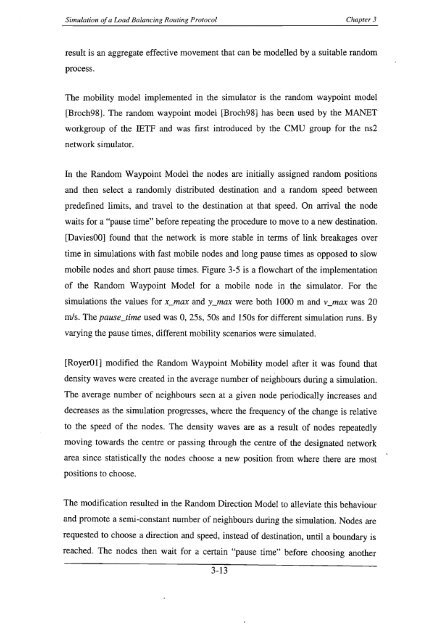Gugrajah_Yuvaan_ Ramesh_2003.pdf
Gugrajah_Yuvaan_ Ramesh_2003.pdf
Gugrajah_Yuvaan_ Ramesh_2003.pdf
You also want an ePaper? Increase the reach of your titles
YUMPU automatically turns print PDFs into web optimized ePapers that Google loves.
SimuLation ofa Load BaLancing Routing ProtocoL Chapter 3<br />
result is an aggregate effective movement that can be modelled by a suitable random<br />
process.<br />
The mobility model implemented in the simulator is the random waypoint model<br />
[Broch98]. The random waypoint model [Broch98] has been used by the MANET<br />
workgroup of the IETF and was fust introduced by the eMU group for the ns2<br />
network simulator.<br />
In the Random Waypoint Model the nodes are initially assigned random positions<br />
and then select a randomly distributed destination and a random speed between<br />
predefined limits, and travel to the destination at that speed. On arrival the node<br />
waits for a "pause time" before repeating the procedure to move to a new destination.<br />
[DaviesOO] found that the network is more stable in terms of link breakages over<br />
time in simuJations with fast mobile nodes and long pause times as opposed to slow<br />
mobile nodes and short pause times. Figure 3-5 is a flowchart of the implementation<br />
of the Random Waypoint Model for a mobile node in the simulator. For the<br />
simulations the values for x_max and y_max were both 1000 m and v_max was 20<br />
rn/s. The pause_time used was 0, 25s, 50s and 150s for different simulation runs. By<br />
varying the pause times, different mobility scenarios were simulated.<br />
[RoyerOl] modified the Random Waypoint Mobility model after it was found that<br />
density waves were created in the average number of neighbours during a simulation.<br />
The average number of neighbours seen at a given node periodically increases and<br />
decreases as the simulation progresses, where the frequency of the change is relative<br />
to the speed of the nodes. The density waves are as a result of nodes repeatedly<br />
moving towards the centre or passing through the centre of the designated network<br />
area since statistically the nodes choose a new position from where there are most<br />
positions to choose.<br />
The modification resulted in the Random Direction Model to alleviate this behaviour<br />
and promote a semi-constant number of neighbours during the simulation. Nodes are<br />
requested to choose a direction and speed, instead of destination, until a boundary is<br />
reached. The nodes then wait for a certain "pause time" before choosing another<br />
3-13
















